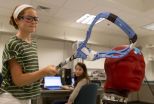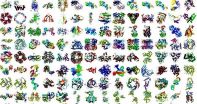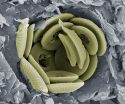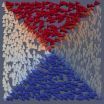Love at first smell
Can birds choose mates by their odors?
2014-12-01
(Press-News.org) Mate choice is often the most important decision in the lives of humans and animals. Scientists at the Konrad Lorenz Institute of Ethology at the Vetmeduni Vienna have found the first evidence that birds may choose their mate through odor. They published their findings in Nature's Scientific Reports.
It has long been understood that reproducing with close relatives may have profoundly negative effects on offspring. It is therefore not surprising that biologists have discovered in some species that breeding individuals have evolved ways to detect their genetic similarity with those of prospective partners. Over 20 years ago it was discovered that female mice were able to choose unrelated over related males as mates. Females achieved this by comparing the smell of the urine of each male and comparing it with their own odors.
Amazingly, the urine odors reflected the genetic composition of each mouse. More specifically, the odors were correlated with a special group of genes called the "major histocompatiabilty complex", or MHC, which helps individuals resist diseases. Thus, by pairing with MHC-dissimilar mates, breeders produce offspring with a more diverse collection of disease-resistant genes.
This discovery in mice was followed by similar findings in other mammals. More recently it has been shown that birds in several species also avoid breeding with MHC-similar mates. This poses a mystery. Whereas smell is a very well developed sense in mammals, it has long been thought that birds lack such keen olfactory abilities. Although a growing body of research is showing that birds can discriminate odors more than previously thought, none had shown that birds can do as mammals and use odor to compare their MHC composition with that of prospective mates. This mystery appears to have been solved by a group of researchers from Austria and France. Team leader Richard H. Wagner and behavioral geneticist Wouter van Dongen of the Konrad Lorenz Institute of Ethology, a part of the Veterinary Medicine University Vienna, have been collabortating with French colleagues on a long-term study of a cliff-nesting gull, the black-legged kittiwake, breeding in Anchorage Bay, Alaska.
When birds groom themselves with their bills, they spread chemical compounds from their preen glands throughout their plumage. These chemicals produce odors that appear to be unique to each individual, providing an olfactory fingerprint. The team suspected that, just as in mammals, these odors may be used by kittiwakes to assess their relatedness to other individuals.
To test this idea, the researchers collected both DNA samples and preen gland odor samples from nesting kittiwakes. The project then entailed two kinds of laboratory work: while Sarah Leclaire at the University of Toulouse conducted the analyses of the preen gland chemicals to characterise the odor signatures of each individual, van Dongen analyzed the MHC of the kittiwakes in the Vienna lab. The team had previously discovered that kittiwakes avoided pairing with relatives, but the mechanism by which the birds recognized their relatedness to each other had remained unknown until now. Their new finding is that individual kittiwakes that smell similarly to each other (i.e. have similar preen gland chemicals) also have similar MHC genes. Closer relatives therefore have more similar odors than distantly related individuals. This suggests that birds may be able to compare their own odor with those of potential mates, and to choose unrelated individuals as breeding partners. Quips ornithologist Wagner, "the more research that is performed on smell, the more it appears that anything mammals can do, birds can do too." The new findings, moreover, open the door for further work linking mate choice and disease-resistance in birds.
INFORMATION:
The Nature Publishing Group has just published the paper "Preen secretions encode information on MHC similarity in certain sex-dyads in a monogamous seabird" by Sarah Leclaire, Wouter F. D. van Dongen, Steeve Voccia, Thomas Merkling, Christine Ducamp, Scott A. Hatch, Pierrick Blanchard, Étienne Danchin & Richard H. Wagner in its online journal Scientific Reports. doi:10.1038/srep06920) http://www.nature.com/srep/2014/141105/srep06920/full/srep06920.html
About the University of Veterinary Medicine, Vienna
The University of Veterinary Medicine, Vienna in Austria is one of the leading academic and research institutions in the field of Veterinary Sciences in Europe. About 1,300 employees and 2,300 students work on the campus in the north of Vienna which also houses five university clinics and various research sites. Outside of Vienna the university operates Teaching and Research Farms. http://www.vetmeduni.ac.at
Scientific Contact:
Richard Wagner
Konrad Lorenz Institute of Ethology
University of Veterinary Medicine Vienna (Vetmeduni Vienna)
T +43 650 343 8077
richard.wagner@vetmeduni.ac.at
Released by:
Susanna Kautschitsch
Science Communication / Public Relations
University of Veterinary Medicine Vienna (Vetmeduni Vienna)
T +43 1 25077-1153
susanna.kautschitsch@vetmeduni.ac.at
ELSE PRESS RELEASES FROM THIS DATE:
2014-12-01
Current data bases hold information on thousands of molecules--including drugs, natural substances, and chemical agents found in the environment-- that are associated with diseases, either because they have adverse effects or exert a therapeutic action. Using this information, gathered over many years and available in data bases, scientists headed by ICREA researcher Patrick Aloy at the Institute for Research in Biomedicine (IRB Barcelona) have devised a predictive model that allows them to associate chemical fragments with positive or negative effects in 20% of human ...
2014-12-01
Athens, Ga. - Debunking the myth of the "mean girl," new research from the University of Georgia has found that boys use relational aggression--malicious rumors, social exclusion and rejection--to harm or manipulate others more often than girls.
The longitudinal study, published online in the journal Aggressive Behavior, followed a cohort of students from middle to high school and found that, at every grade level, boys engaged in relationally aggressive behavior more often than girls.
A team led by UGA professor Pamela Orpinas analyzed data collected from 620 students ...
2014-12-01
PROVIDENCE, R.I. [Brown University] -- Lacrosse players swing hard, which is why errant stick blows are the leading cause of concussion in girls' and women's lacrosse. In a new study, researchers measured how much the worst blows accelerate the head and how much different kinds of headgear could reduce those accelerations.
Girls' and women's lacrosse is a different game from the version played by males, said Joseph Crisco, the Henry Frederick Lippitt Professor of Orthopaedic Research in the Alpert Medical School of Brown University and a researcher at Rhode Island Hospital. ...
2014-12-01
A DRUG that could reduce the harmful side-effects of 'binge drinking', especially by teenagers, has been successfully developed and tested by a team of European scientists, including the University of Huddersfield's Professor Mike Page and Dr Karl Hemming. There is also the potential for new ways to treat Alzheimer's and other neurological diseases that damage the brain.
The key to the breakthrough is a compound developed by Professor Page and colleagues at the University of Huddersfield which is named ethane-beta-sultam. This is a taurine 'pro-drug' - an effective ...
2014-12-01
Knowledge of the three-dimensional structures of proteins is essential for understanding biological processes.
Structures help to explain molecular and biochemical functions, visualize details of macromolecular interactions, facilitate understanding of underlying biochemical mechanisms and define biological concepts.
The human genome and follow-up sequencing projects have revolutionized biology and medicine; structural genomic programmes have developed and applied structure-determination pipelines to a wide range of protein targets, facilitating the visualization of ...
2014-12-01
A study of ancient marine algae, led by the University of Southampton, has found that climate change affected their growth and skeleton structure, which has potential significance for today's equivalent microscopic organisms that play an important role in the world's oceans.
Coccolithophores, a type of marine algae, are prolific in the ocean today and have been for millions of years. These single-celled plankton produce calcite skeletons that are preserved in seafloor sediments after death. Although coccolithophores are microscopic, their abundance makes them key contributors ...
2014-12-01
"A quantum computer may be thought of as a 'simulator of overall Nature," explains Fabio Franchini, a researcher at the International School for Advanced Studies (SISSA) of Trieste, "in other words, it's a machine capable of simulating Nature as a quantum system, something that classical computers cannot do". Quantum computers are machines that carry out operations by exploiting the phenomena of quantum mechanics, and they are capable of performing different functions from those of current computers. This science is still very young and the systems produced to date are ...
2014-12-01
Subliminal visual cues are words, pictures or symbols which are unidentifiable in someone's conscious.
Conducted by Professor Samuele Marcora in collaboration with colleagues at Bangor University, the research discovered that athletes undergoing endurance exercise who were presented with positive subliminal cues, such as action-related words, including 'go' and 'energy', or were shown happy faces, were able to exercise significantly longer compared to those who were shown sad faces or inaction words.
The words and faces appeared on a digital screen - placed in front ...
2014-12-01
Researchers at DESY have used high-speed photography to film one of the candidates for the magnetic data storage devices of the future in action. The film was taken using an X-ray microscope and shows magnetic vortices being formed in ultrafast memory cells. Their work, which has been reported by the scientists surrounding Dr. Philipp Wessels of the University of Hamburg in the journal Physical Review B, provides a better understanding of the dynamics of magnetic storage materials. Magnetic memory cells are found in every computer hard drive.
"Our images allow us to observe ...
2014-12-01
Group mindfulness treatment is as effective as individual cognitive behavioural therapy (CBT) in patients with depression and anxiety, according to a new study from Lund University in Sweden and Region Skåne. This is the first randomised study to compare group mindfulness treatment and individual cognitive behavioural therapy in patients with depression and anxiety in primary health care.
The researchers, led by Professor Jan Sundquist, ran the study at 16 primary health care centres in Skåne, a county in southern Sweden. They trained two mindfulness instructors, ...
LAST 30 PRESS RELEASES:
[Press-News.org] Love at first smell
Can birds choose mates by their odors?






